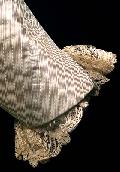A woman’s wedding dress is probably one of the most important garments worn in her life. The outfit worn by Mrs. Grout on 30 June 1897 (as labeled in the bodice) is no exception. The detail and construction is a lovely example of period dressmaking.

Although white was a popular color for weddings, this particular bodice is a light blue material much like silk taffeta, with lengthwise stripes of cream and gray. The bride and groom were more likely working class and a white gown for her might have been extravagant. The bodice could have been worn for traveling after the wedding ceremony.
The bodice, or waist, is very typical of the time period. It is made with a white sateen flat-lining and closely fitted by two breast darts. The flat-lining has a centerback seam with two additional pattern pieces on each side. Quarter inch bones were placed in every seam including the two lining darts for a total of sixteen bones.
 The front panels have three pleats each creating shaping for the bust. The pleats are kept in place by tiny clear glass seed beads spaced in half inch increments from the waist for approximately five inches along the fold of the pleats. The front also features an interesting detail of Chantilly lace that forms a waterfall effect. The lace, which is 6” and one yard long, is gathered around the armseye and tacked to the bodice. The waist edge is faced with a piece of matching fabric cut bias. The bias is 1 ¼” wide and is hand stitched to the lining. The seams are finished with strips of light blue organza hand stitched around the edge of the seam.
The front panels have three pleats each creating shaping for the bust. The pleats are kept in place by tiny clear glass seed beads spaced in half inch increments from the waist for approximately five inches along the fold of the pleats. The front also features an interesting detail of Chantilly lace that forms a waterfall effect. The lace, which is 6” and one yard long, is gathered around the armseye and tacked to the bodice. The waist edge is faced with a piece of matching fabric cut bias. The bias is 1 ¼” wide and is hand stitched to the lining. The seams are finished with strips of light blue organza hand stitched around the edge of the seam.
The centerfront closes left over right with hook and eye tape.
The belt is 4” wide and made from yellow moiré ribbon. It is pleated around the waist. The belt closes on the left front panel of the bodice. The ribbon is gathered into a loop and attaches to the other side with three hooks and eyes.
The standing collar is covered with organza and beaded with pearls and clear seed beads. The inside of the collar is not finished – the fabric has simply been folded over and hand-tacked down. The lace narrows toward the centerfront and gathers into a flounce. A ribbon matching the belt is gathered into two small bows and placed in the centerback of the neck. The collar is attached on the left side of the neckline only. It wraps around the neck and closes at centerback with two hook and eyes.




The sleeves are two-piece “leg of mutton” style. In the year 1897, when this bodice was made, the sleeves became much smaller than that which was popular in previous years. The sleeves on this particular bodice follow this trend and are significantly smaller.
There is an attached inner fitted sleeve made out of the same sateen lining as the bodice. The upper sleeve has three pleats on each side and is gathered at the top. There are two vents at the wrist and matching lace has been pleated and sewn into the inside of the sleeve at the wrist. Curiously, the bottom part of both sleeves have been pieced together. Perhaps there was not enough fabric to cut the sleeve out in one piece. This piecing does not affect the shape of the sleeve.
© Laura Wiggington, 2003








